Feeling somewhat under the weather with some laryngitis today (12/19/15) so it’s time for a quick FNY page of images I got on one of this year’s MTA Holiday Train runs, which occur on all four Sundays in December. As in previous years they are using a trainset made up of cars that originally ran on the Independent Subway, a new set of routes constructed from 1925-1950 by the City to compete with the already existing Interborough Rapid Transit (IRT) and Brooklyn-Manhattan Transit (BMT). Though in many areas, such as Elmhurst and Forest Hills, the IND plumbed new neighborhoods, in other cases it was built to compete with existing lines. That’s why the western Bronx features two lines, the Jerome Avenue El and the Grand Concourse IND line, that parallel each other and in some spots are just a block away from each other. The IND also served to ring the death knell for elevated lines in Manhattan south of Central Park. Indeed, by the time the 6th Avenue line opened in 1940, the old 6th Avenue Elevated train had already been shut down and demolished.
The Holiday run features a trainset consisting of R1 cars, first used on the original IND line, the 8th Avenue, in 1932, and R9 cars built in 1940. The “R” nomenclature, now used for all NYC subway cars, was first developed for the IND, with the “R” standing for Revenue. (The next new cars delivered for NYC subway use will be in the R-170s; the oldest “R” cars in the system today are the R32 cars, which feature corrugated, or rippled, metalwork on their exteriors.)
The R1s and R9s generally have the same proportions and seat arrangements; I won’t get into specifics, since I find all that boring and I suspect everyone else but the hardcore “foamers” do, too. Though all began with rattan wicker seating, some were later fitted with red vinyl (in later years, all gained plastic seating due to vandalism; the cars were lit with bare incandescent bulbs, that later had plastic covers; “straps” were white porcelain (as were vertical handholding bars); and overhead fans (with some futility) attempted to keep the cars cool in summer.
Unlike Chicago’s holiday trains, the MTA’s holiday cars are not festooned and bedecked with neon Christmas decorations, but as we’ll see, the MTA added a new wrinkle this year to address that deficiency. The CTA also runs its holiday specials out most every day in December until he 23rd, but they do use modern cars with holiday trim.
In 2015, December had little to no cold temperatures or snow, so the Holiday Train ignites whatever Christmas spirit remains for the webmaster after 58 years.
Happy holiday crowds in the R-1 car #401, which looks almost the same as when if first rolled over 80 years ago.
The R-9s, modernized in the 1940s, looked a bit drabber but still had soft red seats, bare electric bulbs, and overhead fans.
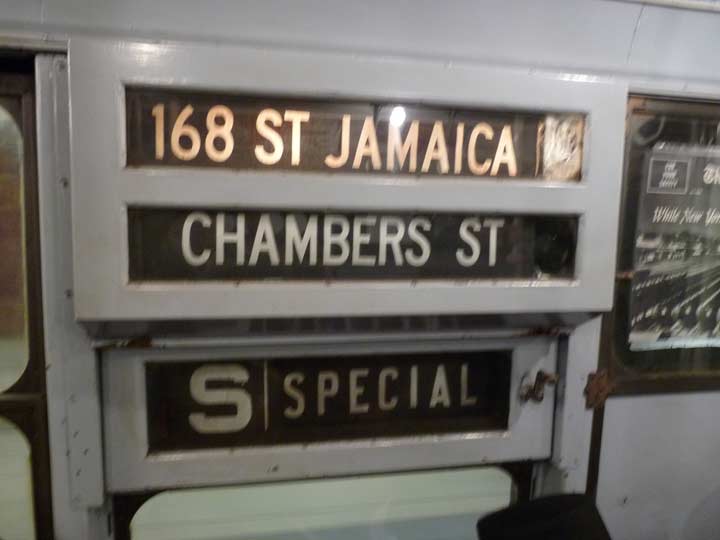
The Holiday Special followed along the current M train route between 2nd Avenue and Queens Plaza. I’m not sure if there was a subway route in 1932 that followed that route (likely not) but the train exclusively passed through Independent Subway stations. This route indicator, though, shows the termini of the old BMT Jamaica Line after the Chambers street station opened in 1913. In the 1980s the el was cut back to 121st Street and a tunnel was built to Parsons Blvd./Archer Avenue, opening in December 1988.
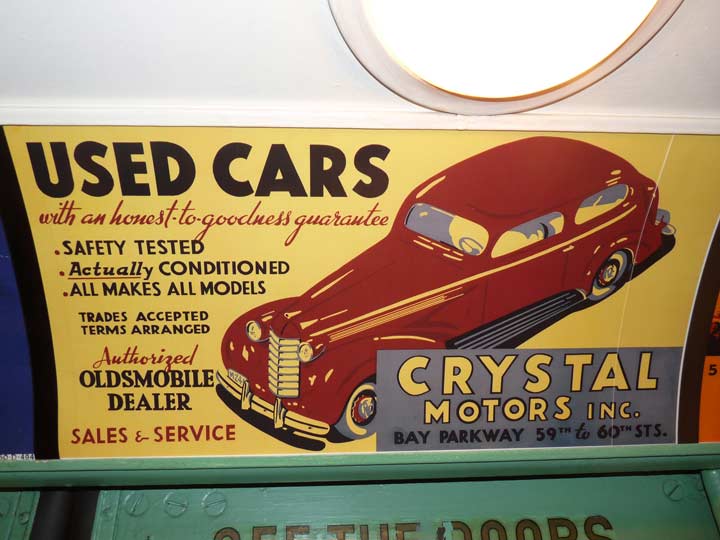
This ad would be placed on cars that used the Culver Line down McDonald Avenue, today’s F train, or the Sea Beach line (N) both of which had Bay Parkway stations. A large Rite Aid drug supermarket now occupies the Used Car lot; this is also nearby the present-day Bishop Kearney High School and St. Athanasius Church — lots of Catholics in Bensonhurst, or used to be.
Oldsmobile was in business between 1897 and 2004, though it became a division of General Motors in 1908.
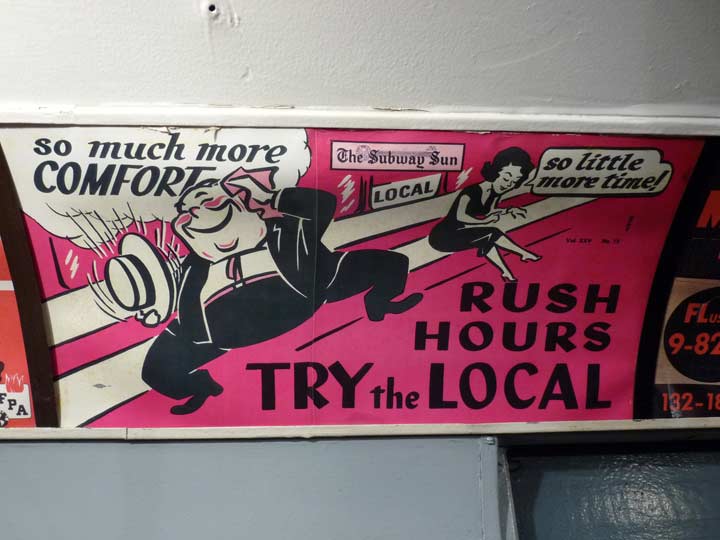
Subway poster by artist Amelia Opdyke Jones, a cartoonist who drew a slew of subway posters that gently and humorously called attention to the shortcomings of subway riders in the manners department as well as supplied helpful advice. I devoted two entire FNY pages to “Oppy’s” oeuvre, here and here.
These days, with ridership at a new peak, taking a local won’t likely help you avoid the crowds. A trick I use is to get on in the front or rear car, which helps about 75% of the time. Fanning yourself with a hat is no longer necessary, either, as all cars are now air-conditioned.
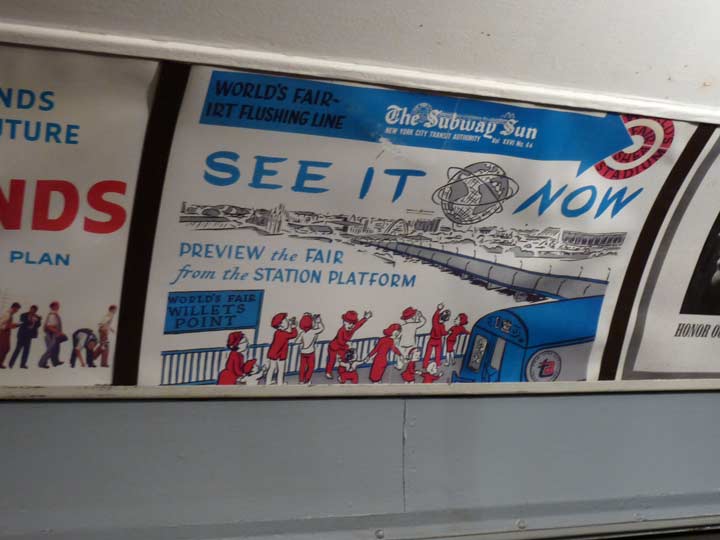
Oppy’s World’s Fair sign was in trains in 1964 and 1965 in then-new R-33 and R-36 cars running on the Flushing Line (#7). Originally they were painted light blue and white, were later graffiti-riddled, and then gained a maroon color, earning them the nickname “Redbirds.” On the train you can see the Transit Authority’s 1960s logo; it was changed when the agency became the Metropolitan Transit Authority.
Here we also see an early error as Oppy repeats the “Willets Point” misnomer. The actual Willets Point is in Bayside at Fort Totten, while a boulevard originally mapped to go there was named Willets Point Boulevard. It was never bridged over the Flushing River and now exists in two pieces, one as the spine of the erstwhile “Iron Triangle” and another cutting through Flushing and Bayside.
I’ve given some thought about why original subway design, which was much more ‘industrial-looking’ for lack of a batter term, with exposed bolts, bare bulbs, etc. was abandoned. When the International building designs arrived around 1950 there was an ever greater emphasis on streamlining. The older trains had some indentations and crevices, and differently-sized seats could be found. Early seats were made with thatched wicker and straphangers really did hang on leather straps.
My idea is that all these bolts, uneven surfaces, and ceiling fans was thought to help to distribute germs. But despite my riding into town on some of the newer cars the other day for an agency interview, I came down with a cold and laryngitis this past week. I don’t think the design of the old cars was much of a factor: if germs want to attack, they will. Designing new subway cars the way they were in the 1910s through 1930s may be just too much expense.
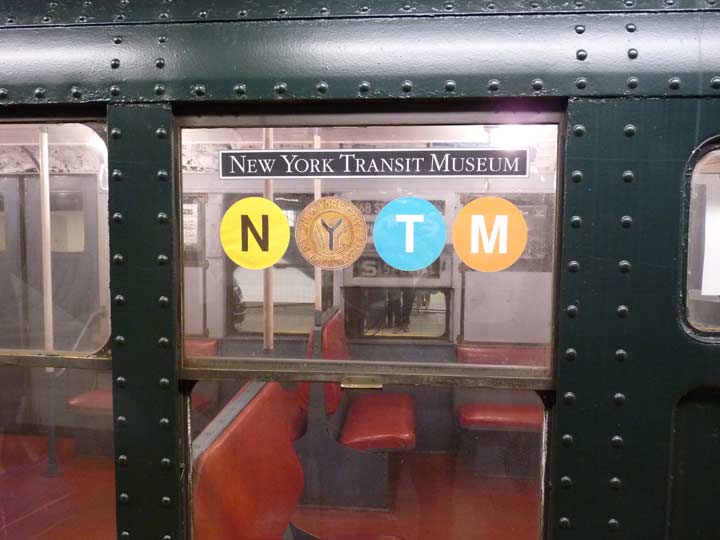
The New York Transit Museum initials were displayed on one of the R-9 windows. The bullet colors of N, T, M are correct — a T train is on the drawing boards as it will be the sole line running on the Second Avenue Subway from 60th Street south to Hanover Square. Doubt persists it will ever be built due to costs, and if work began today the line would likely be finished around 2050.
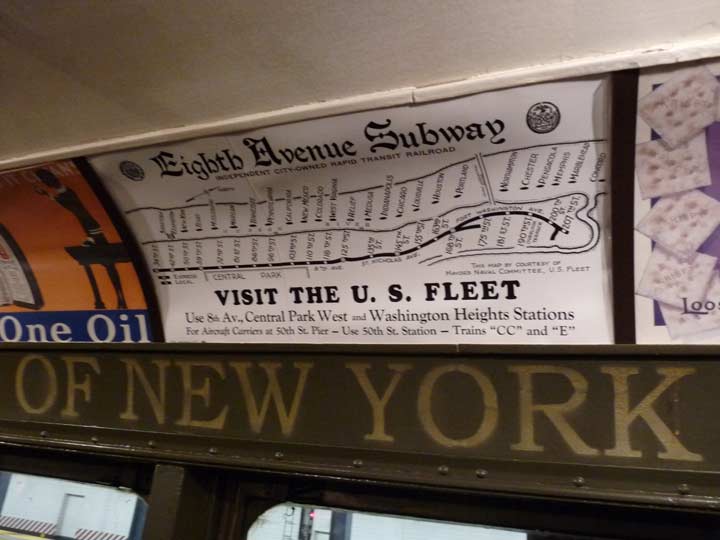
For years, the 8th Avenue Line was the most complicated — nomenclature-wise — in the system, with the A service running express and various combinations of CC, AA and K on the local. Since 1988, the MTA has settled on the A express and C and E local. The E becomes an express in Queens and the C is local in both Manhattan and Brooklyn. The C shadows the A, one of the few subway lines to run on the same line as its express counterpart for its entire length.
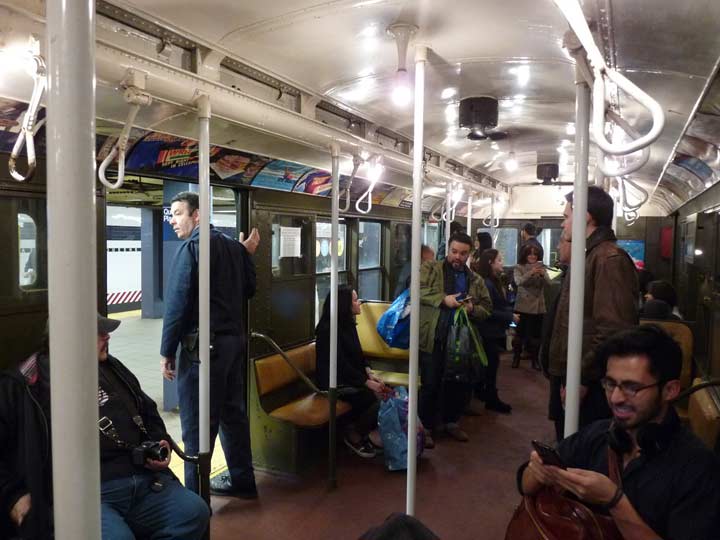
I switched to one of the original R-1 cars in Queens. Few subway cars, except perhaps for their BRT elevated car predecessors — are handsomer cars than these. Note the enamel finish poles and straps, and bare electric bulbs that, according to legend, were made with counterclockwise threads to discourage pilferage. Ceiling fans whir and taller people would have to take extra care.
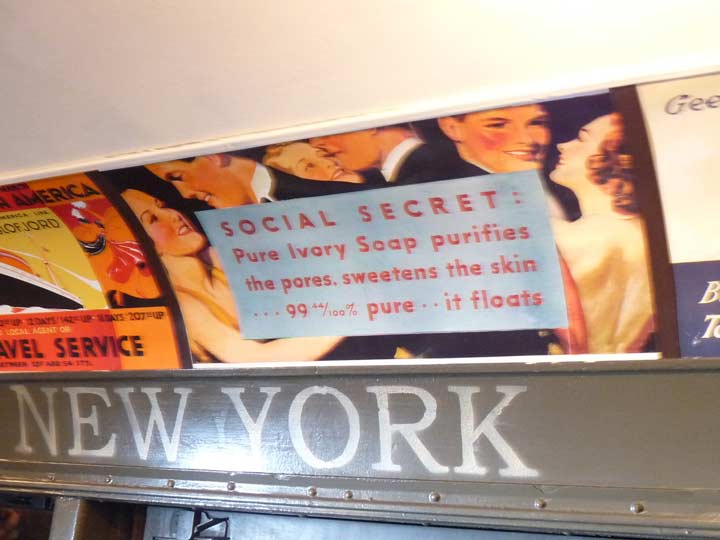
Ivory Soap was formerly produced in factories on the NW end of Staten Island in the Mariners Harbor area along the Kill Van Kull. There were hundreds of employees and shipments were loaded onto and off railroad cars that arrived on the Arthur Kill Bridge to New Jersey. The area was called Port Ivory while the factory was open. Ivory was still using its 99-44/100 percent pure claim well into the 1970s.
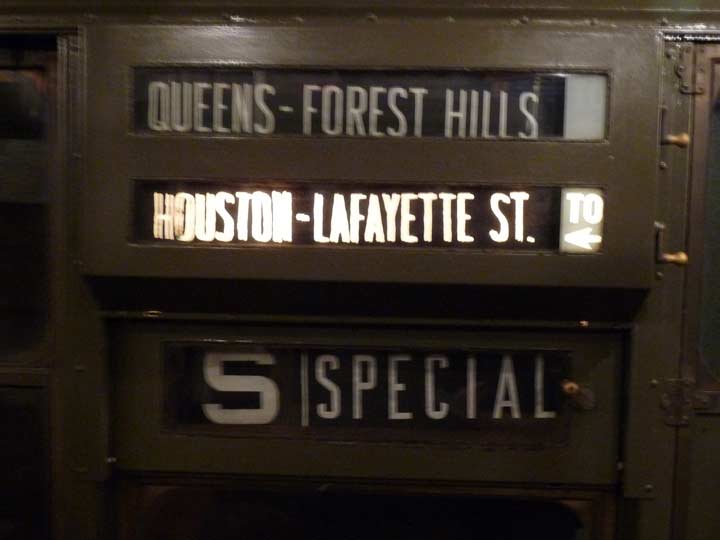
Route indicator on the R-1. I’m not sure which line used the Broadway-Lafayette Street station as a terminal. This line likely used F line tracks on 6th Avenue and local tracks on the Queens Boulevard line.
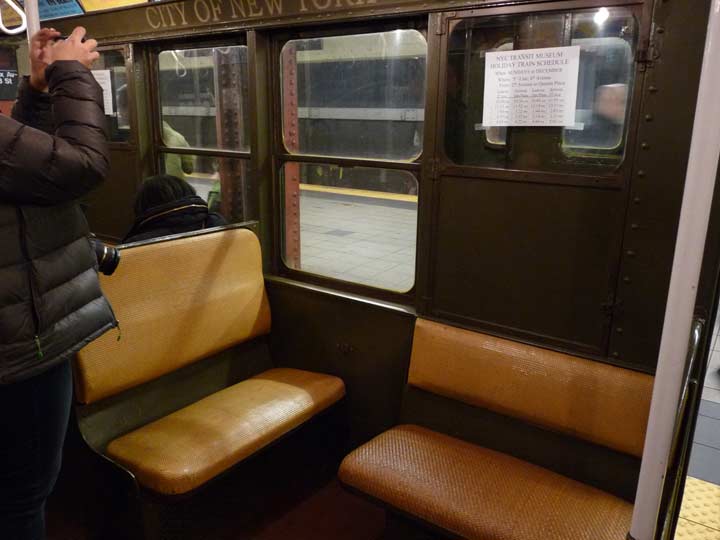
Wicker seats were phased out starting in the late 1950s and replaced by red cushion seats and later, plain plastic. Vandals would enjoy knifing the seats and when the interlocking wicker came loose, the exposed ends would run women’s stockings, so I’ve heard.

Sitting underneath a “No Smoking, Spitting or Throwing Litter on Tracks” sign. Only the first has ever been enforced. Note that seat coverage was smaller, as were people when these subway cars were built in the 1930s. The round edge on the windows has been a subway feature even up to today’s stainless steel cars.
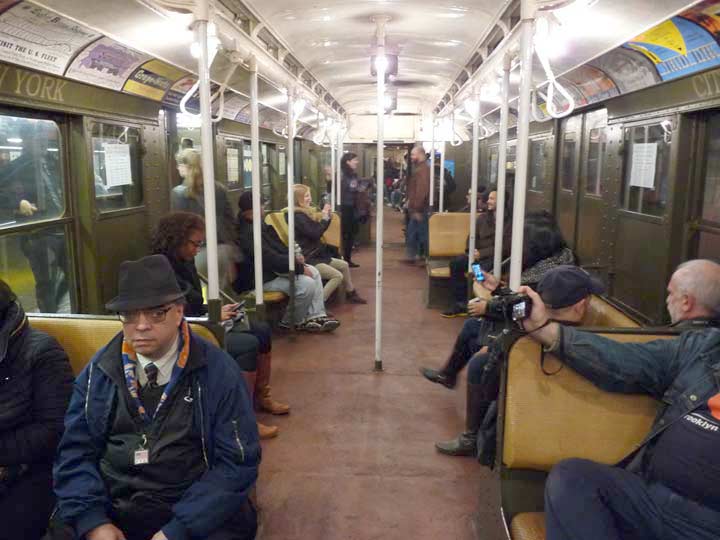
There’s at least one snap brimmed hat wearer in this car. In the 1930s, just about everyone on the train wore headgear.

I wanted to emphasize the visible bolts, bare bulbs and straps in this picture, but I also snagged a few period ads. Most of these products are still available. 3-in-One Oil was invented by George Cole in 1894, named for its ability to “clean, lubricate and protect.” It was purchased by WD-40 in 1995 and is used as a rust and tarnish protector.
Sunshine Biscuits was the popular name for products made by the Loose-Wiles Baking Company beginning in 1902. Sunshine had a large factory in Sunnyside, Queens in a building that still stands, though the company moved out in 1965. The bakery was sold to Kellogg in 2000.
Campbell’s Soup remains the most popular brand of canned soup in the United States. The company was founded by Joseph Campbell in 1869, though the company did not begin canning condensed soup packed in red and white cans until the 1890s.
When I was in high school, for our annual spring trips we bussed it to Rye Playland in Westchester County. The park opened in the spring of 1928 and its signature Dragon Coaster began operation the following year.
Grape-Nuts Cereal was invented by C(harles) W(illiam) Post — who has a college in Nassau County named for him — in 1897. Grape-Nuts are made of wheat and barley and contain no grapes or nuts. The name comes because as originally produced, the cereal looked like nuts or had a nutty flavor, and the glucose formed in the baking process was known as “grape sugar.” They are still distributed by the Post Cereal Company.
It’s a pleasure to ride original R-1 IND cars past stations built at the same time that have kept their original signage and decor. It’s complete Independent Subway immersion.
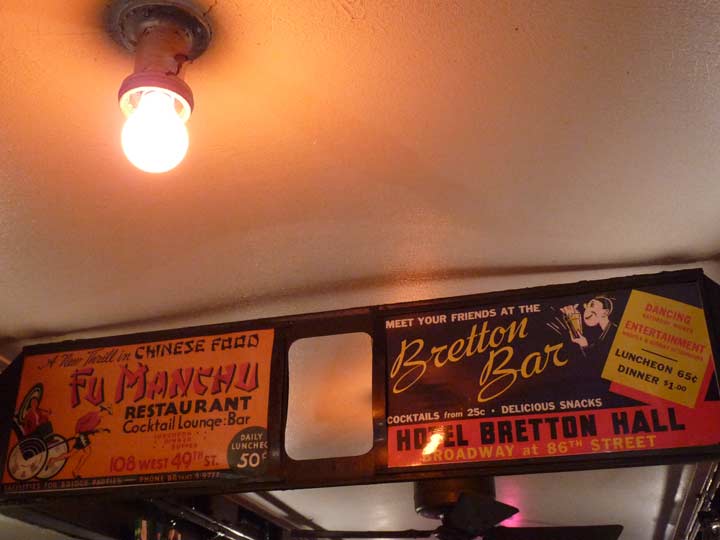
Here’s a postcard view inside the old Fu Manchu Restaurant at 108 West 49th Street, near Radio City. Bretton Hall is still standing on Broadway between West 85th and 86th Streets on the Upper West Side as it has since its completion in 1903. It’s no longer a hotel but a rental apartment building with about 460 units.
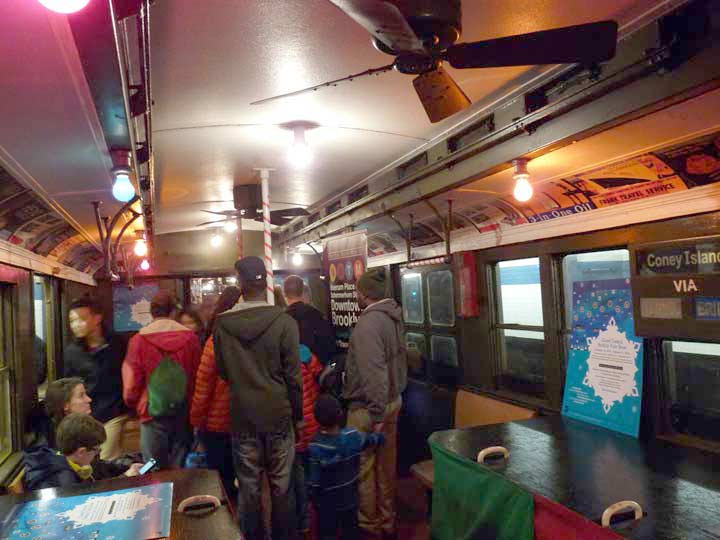
I’ve mentioned that there’s a new addition to the Holiday Train series this year that makes it a bit more like how the Chicago Transit Authority does it. The Transit Museum trotted out two even older subway cars — D-Types built for BMT lines in the 1920s — for exhibit space and as a Transit Museum store. The interiors were decorated for Christmas, and the lightbulbs were in rainbow colors.
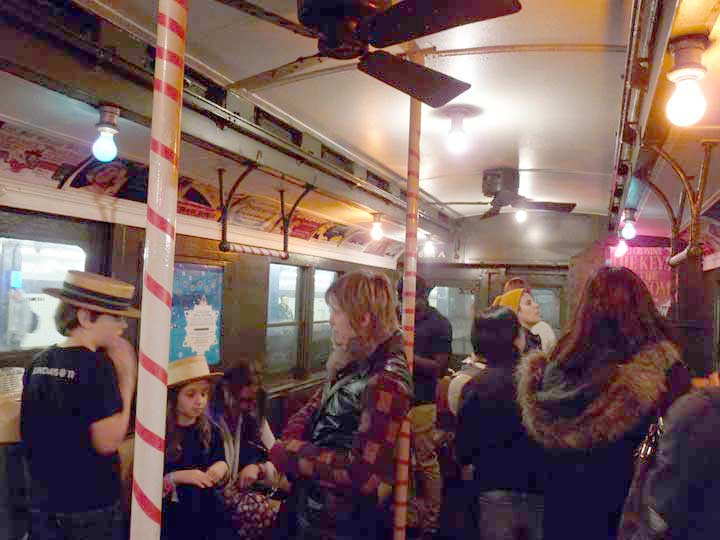
I’d have to give the Museum a thumbs up for this idea, but browsing space in the admittedly narrow subway cars is at a premium.
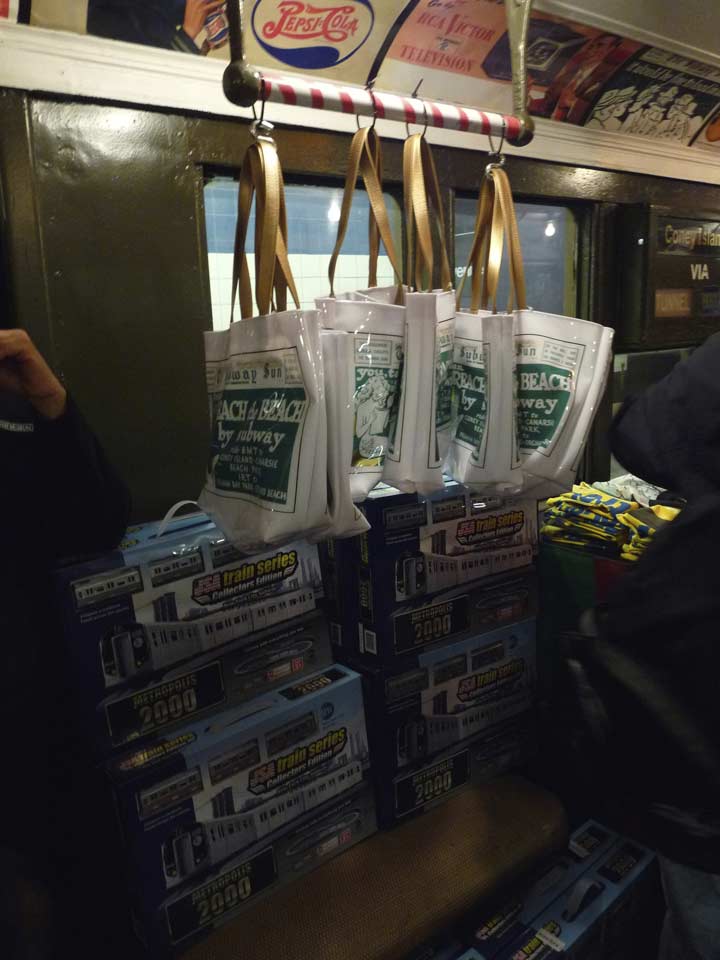
Hopefully “Oppy’s” family is benefiting from the reproductions of her pieces on MTA tote bags. I used to be a model train buff and so the production of model subway cars would have had me in heaven when I was a kid. I wonder if there are any “Slants” (R-40s)
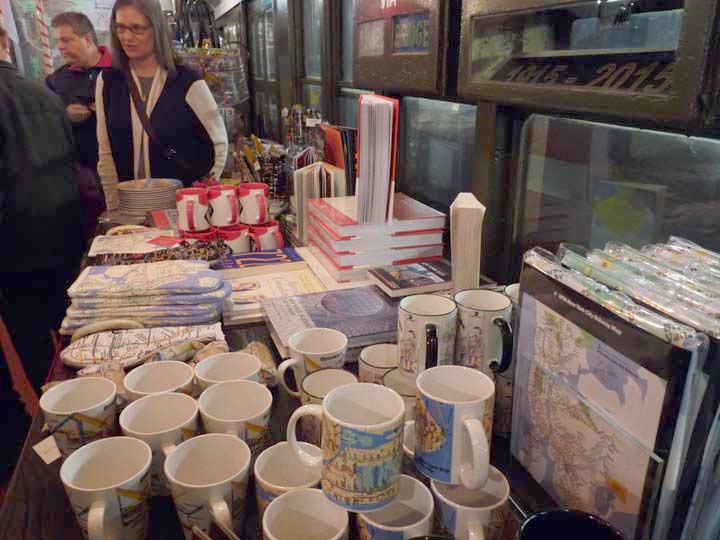
Plenty of mugs, mouse pads, maps and books. All this for a system that daily drives people crazy!
The Brooklyn-Manhattan Transit Corporation was formed in 1923 using the assets of the former Brooklyn-Manhattan Transit, which had foundered after the Malbone Street Wreck in 1918. I do not know why the MTA places the centennial from 1915-2015.
I hope the D-Types are included in a future Transit Museum nostalgia trainset — I would like to ride them again.
12/20/15


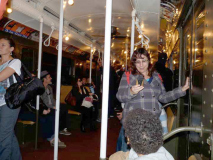
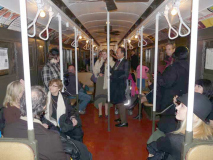
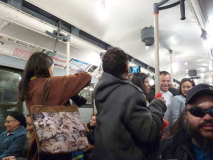
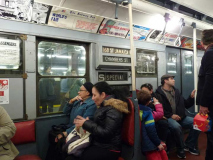
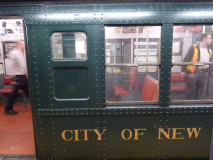
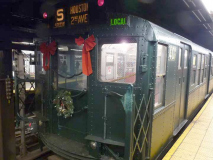
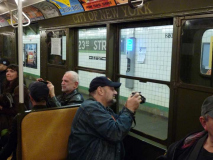
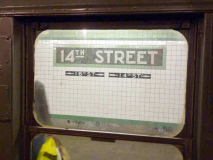
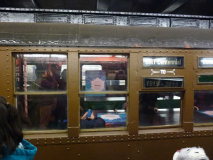
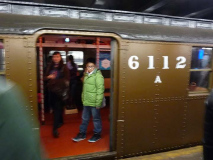
11 comments
You’re right, there is some confusion on the dates. 1915 probably comes from the introduction of the Standard subway cars and the opening of the 4th ave subway, which did occur in 1915. So, it is correct that the BMT’s first subway is 100 years old, but it was operated by the BRT (Brooklyn Rapid Transit) when it opened.
Kevin, wonderful blog. Can you kindly get them to knock down Madison Square Garden and rebuild the original Penn Station, as it was? Greatly appreciated, and keep up the good work from Erik at theory ofirony.com.
That is, theoryofirony.com. Whatever the case, promise me you will get Penn Station rebuilt, ok?
When I first started to ride on old IND trains in the early 50’s, my buddies and I found that they rode hard..as if they had poor or no springs…the BMT cars..the Standards and the Triplex types. seemed to have a “bounce” to them..Only the newer cars that came in the late 40’s that were primarily used on the “A” train seemed more comfortable….We did like the spaciousness of them as opposed to the rather spartan IRT cars of old..
I’m pleased and happy and amazed that the MTA still does this in the year 2015. Beyond the cost of maintaining these trains decade after decade, it’s got to be one of the top-5 “small town” things that you can still do in NYC each year. Bravo.
When I moved to NYC in 1967, the F did use Broadway-Lafeyette as a terminal station.
There was a push a while back to make USPS GPO building the new Penn Station when USPS moves out. I haven’t heard anything further.
I rode both the R-1 IND trains and the BMT Standards when I was a kid. I remember them specifically for the long “groaning” sound the train made every time they sped up or slowed down.
The design of the subway cars (rivets, exposed bulbs, fans and so forth) were consistent with the construction techniques and materials of the times. Rivets were the (then) strongest way to connect two distinct pieces of metal – especially flat pieces.
Advances in metal-working technology during and after WWII allowed for construction techniques to change for subway cars as well.. Stainless Steel came into use with the R-32’s as a finish material, but it was more expensive than regular steel. The selling point was that it was lighter weight and much less prone to corrosion. It could be left unpainted, while other materials required regular upkeep to prevent deterioration. The reduced maintenance cost over the life of the car off-set the higher initial price. By the 1980’s, adhesive technology had advanced to the point where glue was being used in places where rivets were used 75 years earlier.
Current cars have fluorescent lighting and air conditioning. LED’s are already in use for indicators and messaging. I suspect that 75 years from now folks will be nostalgic for these things when the new cars are lit and cooled by some yet-to-be-imagined technology.
And yes – the incandescent bulbs used on subway cars are reverse-threaded so that riders would not ‘liberate’ them for use at home.
Not to be persnickety, but the R-9s were not refitted R-1s. They were a separate contract for 153 additional cars for the IND built in 1940 to provide cars for the 6th Avenue Subway. The R-1 thru R-9 cars were actually built under 11 different contracts by 3 different manufactures between 1930 and 1940.
For full details and R-1 to R-9 series/contracts, see:
http://nycsubway.org/wiki/The_Independent_Fleet_(1932-1939)
Kevin – Nice writeup. Your camera’s white balance erased most of the warmer tone of the R1’s dim incandescent bulbs. Or perhaps the current bulbs are not incandescent because somehow the museum found left-threaded LEDs. Either way, in your photos these venerable cars look significantly brighter and whiter than during their original run.